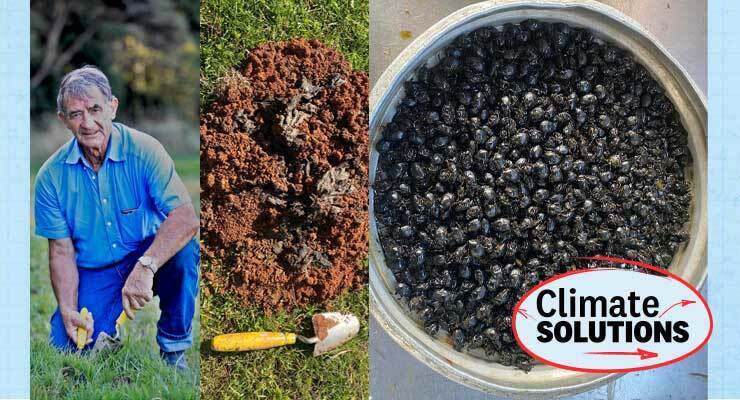
This is part two in a series about searching for solutions to the climate emergency. Read parts one, three, and four.
World leaders at the UN’s COP27 climate summit no longer have the luxury of burying their heads in the sand when it comes to climate action. That’s not so for the dung beetle. For more than 50 years, populations in Australia have helped bury part of the problem: cow poo.
Add dung beetles to a property with 4000 head of cattle and 30 tonnes of poo and the paddock is as “clean and clear as the fairway on a golf course”, dung beetle expert and distributor John Feehan says.
But they bring much more than aesthetics to the (underground) table.
Let’s dig in.
The poo problem
Australia has 28 million head of cattle that collectively drop nearly half a million tonnes of dung every day. Scaled up for annual output, that’s 182.5 million tonnes plopped in paddocks.
Australia imports about half a million tonnes of phosphate fertiliser from Canada, Florida, China and Morocco each year to placate this it. It’s costly (benchmark $25,000 a year for a big cattle farmer) and a short-term solution for soil enrichment. The chemicals are mined, processed, stockpiled and dropped on the same paddocks the cattle graze in, so (naturally) they therefore wind up in wagyu and waterways.
Compare that with the burial practices of dung beetles. They produce nutrients that stay in the ground for hundreds of thousands of years improving soil fertility, carbon sequestration (healthy soil is on par with ocean plankton), and reducing nutrient and chemical run-off.
Dung beetles perforate a paddock with holes so when heavy rain comes, herbicides, pesticides, wetting agents (insert fertiliser of choice) and residual organic matter runs into the holes rather than river systems. The toxicity of these products (diminishing with the rise of dung beetles) is filtered and neutralised underground.
“A farmer gets 1000 times more benefit from one species of dung beetle than they ever would from one tonne of fertiliser,” Feehan says.
“Dung beetles produce all these benefits without tractors, without machinery, without using farmers’ time and resources, without fossil fuels, and without producing any CO2. It’s a real freebie that nature has produced for us.”
The beetles have also banished the bushfly that breeds in unburied dung.
“You could hardly eat a sandwich outdoors in the summer,” Feehan says. “But last summer and this summer are the first in Canberra and other parts of southern Australia that will be bushfly free.”
Job description of a dung beetle
In short: adult dung beetles smell, then flock to fresh dung. They nibble on the nutrients and then work in tandem to dig a tunnel (30mm down), roll the dung down the tunnel (as much as 50 times their weight), bury the waste (as much as 250 times heavier than itself in a single nightshift), and finally mate (on the job).
Different dung beetles operate in different climates. Within colonies, the beetles specialise as “rollers”, “tunnellers” and “dwellers”. The latter lead a life of leisure, simply existing in the manure.
Why old science needs time to work
Feehan was part of the mid-1960s-80s CSIRO team that introduced 55 species of dung beetles into Australia. The research was world leading and pioneered by Hungarian-born Australian migrant George Francis Bornemissza.
Although federal government funding for the program was cut because the “return was not immediate”, Feehan has continued the work in the decades since, releasing almost 7000 colonies on “every corner of the continent”.
“When you’re changing nature, you need to appreciate that nature doesn’t change very rapidly,” he says.
John Richard’s 1500-acre feedlot farm in Coolah, now home to 13 species of dung beetles, says that changes to the quality of his paddocks did not happen overnight: “If you get a breeding colony of beetles, you’re not going to see activity from those until the third year.”
He says that now their activity is seasonal, but at “times of plenty” dung beetles will disappear a big dung pat overnight: “It’s visibly obvious what’s happening with the manure disposal.”
When the CSIRO program timed out, just one of 44 introduced beetle species had reached its climatic and geographical limits. Now Feehan says Australia has 25 well-established species. And big producers are increasingly taking notice.
Feehan is fielding 10-15 orders a day for dung beetle starter colonies. Generally, one colony consists of 1000 “ready to breed” beetles that are packaged up and sent express around the country with Australia Post.
The beetles are making a comeback.








Of course government funding stopped. He was never going to match the donations from the big chemical companies. I suppose the beetles may have been eligible for mining subsidies as they do make holes in the ground.
As a child in the 70s bushflies were terrible in WA. I can still see my Dad’s back covered with them. Food was always covered with netted domes at barbecues or picnics. The smell of aeroguard lingered on my clothes.
Our Agriculture department got involved with the dung beetle project and voila! After 20 years or so they were gone!
A great success, and a happy climate change story. Thanks Crikey.
ditto – I have thought for a while now that there are way less flies in in a WA summer than there used to be, and I too remember when anyone outside would have their whole back covered in a mass of flies – and we just thought it was normal!
Lovely writing, thanks Julia.
Does anyone remember when that scholar Toned Abs made the CSIRO swallow one third of itself?
Climate science was cut holus bolus, as was anything to do with “Climate” because the scholar himself with a BA knew that climate change was “BS”.
Thank you for persisting in a long endeavour to help Australia out of the s–t.
My recollection is that Toned did not get a chance to abolish the dung beetle project because Paul Keating had already done it with the help of the Treasury. That was the Department that also got rid of CSIRO,s wool scouring machinery being used by the alpaca industry so the processing could be moved to China.
Fantastic John Feehan . . . for your perseverance.